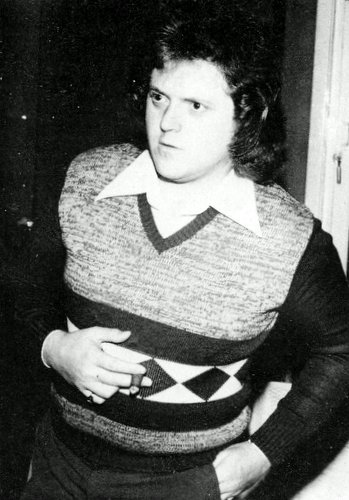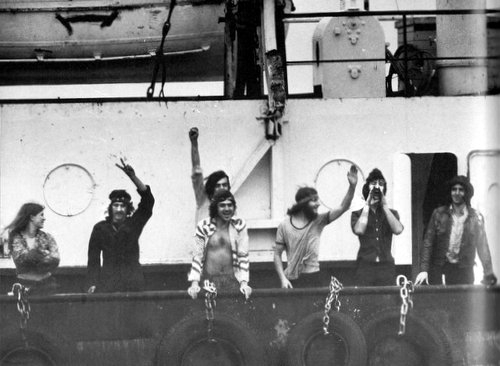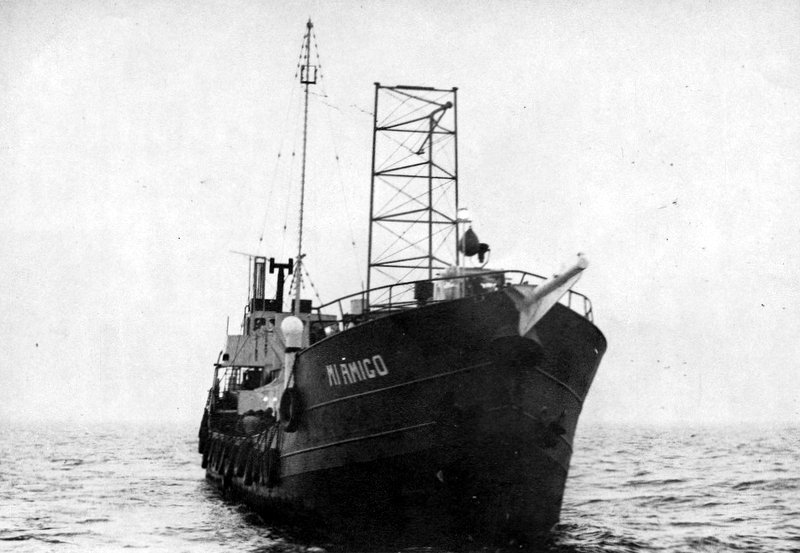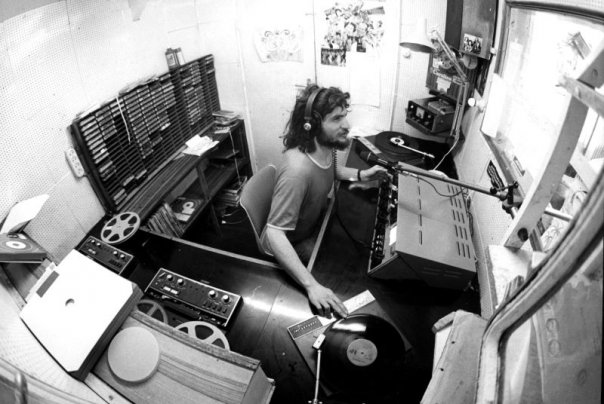With the two service Radio Caroline silenced by generator failure, the break in transmissions gave Robin Adcroft, Dick Palmer,
Bob Noakes, Norman Barrington and the crew time to complete the erection of the aerial mast.
|

|
|
Adriaan van Landschoot. Photo by B.Dom from ‘Offshore Radio’, published by Iceni Enterprises.
|
Meanwhile on land a new backer was found to inject some money into the venture. Adriaan van Landschoot was, at 25, already a millionaire. The owner of a chain of boutiques and a record company
in Belgium, he had a number of interests in the music business. But he wanted something more - his own radio station. It was a perfect match. He had money, Caroline had a transmitter and so a new station, Radio
Atlantis, was born.
Van Landschoot built some studios in Oostburg, Holland and a team of DJs began pre-recording shows for the new station. His money allowed the purchase of new generators for the ship and, during the first week in
July 1973, anonymous and sporadic test broadcasts began from the Mi Amigo. On Sunday 15th July non-stop Beatles music was played from 10am to noon on 1187 kHz. The reception was excellent because, for the first time,
the transmitter was operating at its full 50 kW power and the new 180 ft. mast was being used.
The launch of the new station was not widely publicised so many listeners were surprised when, at 12 noon on 15th July, the station's identity was revealed, not as Radio Caroline but as Radio
Atlantis. Pre-recorded programmes in Flemish then began and continued until 7pm. The Dutch service of Caroline was no more and, in its place, Radio Atlantis was hiring thirteen hours of airtime a day at a cost of
£2,000 per week. Confusion was caused by Atlantis announcing its wavelength as 385 metres. This was because the station had originally intended using the 773 kHz transmitter for the Belgian programmes, while Caroline
continued on 1187, but the ship was not ready for twin broadcasts.

 Tony Houston opening up Radio Atlantis on day one, 15th July 1973. This is an edited version of a recording available from www.azanorak.com. Our thanks to
Ray Robinson (duration 2 minutes 32 seconds)
Tony Houston opening up Radio Atlantis on day one, 15th July 1973. This is an edited version of a recording available from www.azanorak.com. Our thanks to
Ray Robinson (duration 2 minutes 32 seconds)
Atlantis only broadcast during the day. At night non-stop rock music was played by the Caroline staff. Then on 24th July 1973 another station was launched as the night-time rock music was put into
programme format and Radio Seagull was born.

Back in 1970 a company owned by record producer Jimmy Miller and pop manager Tony Secunda had hired airtime from Monaco's Radio Monte Carlo and started broadcasting late night free-form “hippy”
programmes across Europe under the name of Radio Geronimo. These programmes were an erratic but interesting mix of rock with some jazz and classical music, presented with a deliberately laid-back and informal style. The
project won a loyal audience, estimated as 350,000. Although it made no money, Radio Monte Carlo spotted the potential for a progressive music station and decided to drop Geronimo and replace it with programmes of their
own. Geronimo was forced to close, to be replaced by Radio Monte Carlo International. A few years later some of the former Geronimo staffers, still believing in the concept of free-form album-based radio, linked up with
Radio Caroline's founder Ronan O'Rahilly to create Radio Seagull.
The first show from the new station began at 8pm on 24th July 1973. After that, regular programmes ran each night from 9pm to 5am (later 6am). Combining the adventurous musical policy of Geronimo with the personality of
Caroline gave some fascinating (if occasionally self-indulgent) results.
The launch of Radio Seagull, as reported by Script and Monitor magazines, can be found here.
 Barry Everitt broadcasting in rough seas on Radio Seagull on 26th July 1973. This is an edited version of a recording posted on The Offshore Radio Club Forum by Hans Hendriks. Our thanks to him (duration 2 minutes 31 seconds)
Barry Everitt broadcasting in rough seas on Radio Seagull on 26th July 1973. This is an edited version of a recording posted on The Offshore Radio Club Forum by Hans Hendriks. Our thanks to him (duration 2 minutes 31 seconds)
|

|
|
From left: Caroline House librarian Elija, engineer Mike Philpott, Barry Everitt, Andy Archer, Norman Barrington, Robin Adcroft and Mike The Poet. Photo by Theo Dencker from
Last of the Pirates, Paul Harris Publishing.
|
Normally operating at 50 kilowatts, Seagull had a superb signal and, although the free-form programmes received a mixed reception from some old Caroline fans, the station did pick up a following.
Andy Archer was in charge, assisted by Norman Barrington, DJ/engineers Dick Palmer, Bob Noakes and Peter Chicago, with Geronimo stalwarts Barry Everitt and
Hugh Nolan. Tony Allan rejoined the ship in September. Although British listeners had now lost the all-day service of Radio Caroline, at least they had Seagull entertaining them at night, paid for by the success of the daytime Radio Atlantis. This revenue even allowed for the employment of a captain and crew for the Mi Amigo (for most of 1973 Dick Palmer had acted as captain).
New studio equipment was purchased and, despite ructions on land with the departure of station manager Chris Cary, his former secretary Charlotte Ribbelink took over running the office and life went on. Cary was not happy
with Radio Seagull. His own musical tastes were more main-stream and he believed that, if the station was ever going to capture a big audience, it had to be more populist.
 Bob Noakes on Radio Seagull on 23rd September 1973, including a dedication for your web-master. This is an edited version of a recording kindly provided by Hans Knot (duration 4 minutes 41 seconds)
Bob Noakes on Radio Seagull on 23rd September 1973, including a dedication for your web-master. This is an edited version of a recording kindly provided by Hans Knot (duration 4 minutes 41 seconds)
| RADIO SEAGULL PROGRAMME SCHEDULES 1973 |
| Schedule varied from day to day. Examples: |
| 25th July 1973 |
16th August 1973 |
17th September 1973 |
9.00pm Andy Archer
12.00am Barry Everitt
3.00 Norman Barrington (-6.00)
|
9.00pm Andy Archer
11.00 Bob Noakes
12.00am Hugh Nolan
3.00 John Farlowe (-6.00)
All times BST/CET.
|
9.00pm Johnny Jason
12.00am Andy Archer
3.00 Baas (-6.00)
|
By September 1973 the mv Mi Amigo had been back at sea for one year. During that time she had broadcast as Radios 199, Caroline, Atlantis and Seagull. The ship had been transformed from a near-wreck
to a reasonably serviceable and sea-worthy vessel. New generators and a new mast had been fitted and, although the all-day English service was still a long way off, things were going well. Audience response to Atlantis
on the Continent was so good that the organisation had even able to sell the spare hour of airtime between Atlantis and Seagull at the weekend to another Belgian company. After a number of different names, this programme
eventually became known as Radio Mi Amigo.
 Radio Atlantis closing for the night, the beginning and end of the Radio Mi Amigo programme presented by Bart van de Laar, an announcement by Ian Anderson throwing forward to Radio
Seagull in an hour's time and the start of Seagull's programmes with Johnny Jason. This recording was posted by Scotty on the Internet Radiocafé, now known as the
Radiotrefpunt (radio meeting point). Our thanks to him (duration 3 minutes 37 seconds)
Radio Atlantis closing for the night, the beginning and end of the Radio Mi Amigo programme presented by Bart van de Laar, an announcement by Ian Anderson throwing forward to Radio
Seagull in an hour's time and the start of Seagull's programmes with Johnny Jason. This recording was posted by Scotty on the Internet Radiocafé, now known as the
Radiotrefpunt (radio meeting point). Our thanks to him (duration 3 minutes 37 seconds)
|

|
|
The remaining stump of the aerial mast. Photo from ‘Caroline - A Story In Pictures’, published by Threemaster Productions.
|
Then, just as it seemed that the future looked secure, fate intervened once again. On Monday 1st October, in perfectly calm seas, the new mast gave way at its weak spot (the incorrectly assembled section, mentioned previously). It buckled and snapped. The station was abruptly silenced as the huge edifice hung dangerously over the side of the ship. It was cut free and a temporary wire aerial erected. Low powered transmissions
continued but reception was terrible. On 18th October the remaining bit of the mast came down and even this feeble output came to a halt.
This was not the way van Landschoot had planned it but, behind the scenes, he had been making arrangements to sever his alliance with Caroline for some time. He had secretly bought his own ship and was planning to break
away. Fortunately a replacement backer was found. Sylvain Tack, the Belgian businessman who had been hiring two hours a week as Radio Mi Amigo, agreed to take over all the station's daytime output from Atlantis. He fed money
into the organisation and new studios were equipped in Caroline House to record his programmes.
A new mast was obtained for the Mi Amigo by an incredible stroke of luck - or sharp practice, depending on whose version of events you believe. A collapsible 165 ft. antenna had been commissioned by
van Landschoot for his new Atlantis ship from a wrought iron gate manufacturer in Scheveningen. Eddie de Boeke, an associate of Sylvain Tack's, heard of the rival's new mast and found out when it was due to be collected.
Van Landschoot had paid the deposit but when the Atlantis men arrived with the cash to pay the balance and collect the finished aerial, they discovered that they had been beaten to it. A team from the rival station had
turned up, paid the money and taken their antenna. This was rapidly rushed out to sea. Atlantis not only had no aerial but van Landschoot had also lost his deposit. The Caroline version of this story is, as might be expected,
somewhat different. They claim that van Landschoot had refused to pay the agreed amount for his mast, after it had already been constructed, expecting the iron works to drop the price. Instead they contacted Ronan O'Rahilly
and asked if he would like to buy a cheap aerial mast for his ship. He would and the deal was quickly concluded. Whichever version is correct, the fact was that the Mi Amigo had gained a new antenna.
An interview with DJ Norman Barrington appeared in Record and Radio Mirror in early December in which he talked about Radio Seagull - see here.
Rough seas delayed erection of the new mast but finally the team of professional riggers managed it and on 24th December 1973 the first tests went out on 1187 kHz using the 10kW transmitter. The next day, Christmas Day,
a full day's programmes were broadcast - and, in some cases, re-broadcast as Caroline relayed news bulletins and the Robb Eden show from RNI with additional running commentary provided by
Andy Archer! Andy, Norman Barrington, Mike Wall-Garland (“Mike The Poet”) and Peter Chicago were joined on the air by Dutch crew members to transmit their seasons greetings. There were
quite a few references to The Toad, an in-joke between the Caroline and RNI teams referring to DJ Mike Ross. Soon after 1am GMT on Boxing Day morning, Andy closed down the station for the
night with one final toad gag.
 Christmas Day test transmissions from the Mi Amigo, including a short extract of Andy Archer re-broadcasting the Robb Eden show from RNI. This is an edited version of a recording posted on
The Offshore Radio Club Forum by Alex. Our thanks to him (duration 5 minutes 36 seconds)
Christmas Day test transmissions from the Mi Amigo, including a short extract of Andy Archer re-broadcasting the Robb Eden show from RNI. This is an edited version of a recording posted on
The Offshore Radio Club Forum by Alex. Our thanks to him (duration 5 minutes 36 seconds)
Two days of spasmodic broadcasting followed and the last four days of 1973 were taken up with test transmissions, announced as being for Radio Mi Amigo. At 12 noon CET (11am GMT) on 1st January 1974
this new station officially opened for business, broadcasting 6am-8pm each day.
They weren't the only ones opening a new station over Christmas 1973. On 1115 kHz Crispian St.John, Andy Anderson and Johnnie
Dwyer were putting out low powered tests for Radio Atlantis from their new ship, the Jeanine. On 31st December it too officially opened.
Initially Radio Mi Amigo only used the 10 kW transmitter but on the night of 6th January the 50 kW was tested and, when these transmissions ended, Peter Chicago announced that from the next day the big transmitter
would be used full-time and Radio Seagull would return the following night at 9pm.
 Andy Archer and Johnny Jason re-opening Radio Seagull on the evening of 7th January 1974. This is an edited version of a recording available from www.azanorak.com.
Our thanks to Ray Robinson (duration 5 minutes 2 seconds)
Andy Archer and Johnny Jason re-opening Radio Seagull on the evening of 7th January 1974. This is an edited version of a recording available from www.azanorak.com.
Our thanks to Ray Robinson (duration 5 minutes 2 seconds)
|

|
|
Mike Hagler on the air, a photo Mike has shared on Facebook.
|
So on 7th January 1974, after a three month break, Andy Archer and Johnny Jason re-opened Radio Seagull with a programme of music written by George Harrison. (The former Beatle was rumoured to have made
contributions to the station's finances.) The ex-Geronimo guys were gone, fed up with not being paid, but the familiar voices of Bob Noakes, Norman Barrington and Tony Allan returned and Seagull was soon broadcasting through
to 6am each day. Others heard included American cook Mickey Mercer, Mike Hagler - an American DJ who had previously worked in California - and Radio Mi Amigo's
British technician Brian Anderson.
 Mike Hagler on Radio Seagull at 11pm on 17th February 1974 (duration 1 minute 6 seconds)
Mike Hagler on Radio Seagull at 11pm on 17th February 1974 (duration 1 minute 6 seconds)
 Brian Anderson opening up Radio Seagull for the evening on 12th January 1974. Both clips are taken from recordings available from www.azanorak.com.
Our thanks to Ray Robinson (duration 3 minutes 27 seconds)
Brian Anderson opening up Radio Seagull for the evening on 12th January 1974. Both clips are taken from recordings available from www.azanorak.com.
Our thanks to Ray Robinson (duration 3 minutes 27 seconds)
Radio Seagull managed to gather an audience but its free-form programming was not to everyone's taste and, in an effort to increase ratings, it was decided to bring back a more formatted structure,
and a more familiar name. On 23rd February 1974 Radio Seagull was no more - Radio Caroline was back.
Although the original Radio Seagull only lasted a few months, a modern-day version of the station lives on, broadcasting from a ship, the Jenni Baynton, moored in Harlingen Harbour in the
Netherlands. Radio Seagull can be heard on-line via its website.
|

